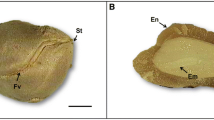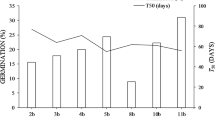Abstract
Seeds of many woody plant species have one of several types of dormancy. They do not germinate unless specific environmental signals are in place or events occur. This study was conducted to evaluate the effects of scarification treatments on seed dormancy and germination of Acacia nilotica (L.) Willd. ex Del., Prosopis juliflora (Sw.) DC. and Dodonaea viscosa (L.) Jacq. The following treatments were applied: T1, untreated seed (control); T2, sulphuric acid (97%) for 45 min; T3, boiling water for 5 min. The seeds were cultured on a Murashige and Skoog (MS) medium after sterilization. The responses of seeds to treatments were compared with each other and with the control treatment. Germination was observed daily for a 30-day period. Results indicated positive responses to treatments, while impermeable seed coats may be responsible for low germination rates in intact seeds as seen experimentally in the untreated control. The highest germination was obtained for P. juliflora and D. viscosa acid-scarified seeds (80.8%–90.8%) and for scarified seeds of A. nilotica (50.2%) boiled in water. The germination indices, i.e., final germination percentage (FG), mean daily germination (MDG) and germination rate (GR), were significantly affected by treatments and species (p < 0.01).
Similar content being viewed by others

References
Aliero BL. 2004. Effects of sulphuric acid, mechanical scarification and wet heat treatments on germination of seeds of African locust bean tree, Parkia biglobosa. Afr J Biotechnol, 3: 179–181.
Anilreddy B. 2009. Preparation, characterization and biological evalution of some overview of Dodonaea viscosa Linn. J Pharma Sci Technol, 1: 1–9.
Babashpour Asl M, Sharivivash R, Rahbari A. 2011. Effect of different treatments on seed germination of honey locust (Gleditschia triacanthos). Mod Appl Sci, 5: 200–204.
Bamel JS, Srinivasan K, Saxena S, Uprety M, Bhatnagar Neelam. 2007. Methods for breaking seed dormancy in Acacia species. Indian J Plant Gen Res, 20: 28–31.
Baskin JM, Baskin CC. 2004. A classification system for seed dormancy. Seed Sci Res, 14: 1–16.
Baskin JM, Davis BH, Baskin CC, Gleason SM, Cordell S. 2004. Physical dormancy in seeds of Dodonaea viscosa (Sapindales, Sapindaceae) from Hawaii. Seed Sci Res, 14: 81–90.
Bonner FT. 2000. Prosopis L. mesquite. USDA Forest Service, Southern Research Station, Mississippi, Mississippi State.
Cook A, Turner SR, Baskin JM, Baskin CC, Steadman KJ, Dixon KW. 2008. Occurrence of physical dormancy in seeds of Australian Sapindaceae: A survey of 14 species in nine genera. Ann Bot, 101: 1349–1362.
Eira MTS, Caldas LS. 2000. Seed dormancy and germination as concurrent processes. R Bras Fisiol Veg, 12: 85–104.
Fagg C. 2001. Acacia nilotica: pioneer for dry lands. In: Roshetko JM (ed) Agroforestry Species and Technologies. Winrock International, Arizona, pp 23–24.
Lima PCF. 1985. Prosopis juliflora management at the Brazilian Northeast. Symposium of Establishment and Productivity of Tree Plantings in Semi Arid Regions. Kingsville, USA.
Lopez BC, Rodríguez R, Gracia CA, Sabaté S. 2006. Climatic signals in growth and its relation to ENSO events of two Prosopis species following a latitudinal gradient in South America. Glob Change Biol, 12: 897–906.
Masamba C. 1994. Presowing seed treatments on four African Acacia species: appropriate technology for use in forestry for rural development. For Ecol Manage, 64: 105–109.
Panwar P, Bhardwaj SD. 2005. Handbook of Practical Forestry. Agrobios, India, p 191.
Pasiecznik NM, Felker P, Harris PJC, Harsh LN, Cruz G, Tewari JC, Cadoret K, Maldonado LJ. 2001. The Prosopis juliflora — Prosopis pallida Complex: A Monograph. HDRA, Coventry, UK, p 172.
Pearman G, Oyen LPA, Lemmens RHMJ. 2002. Dodonaea viscosa Jacq. PROTA (Plant Resources of Tropical Africa/Ressources végétales de l’Afrique tropicale), Wageningen, Netherlands. http://database.prota.org/search.htm. Accessed 2 Sep 2012.
Phartyal SS, Baskin JM, Baskin CC, Thapliyal RC. 2005. Physical dormancy in seeds of Dodonaea viscosa (Sapindaceae) from India. Seed Sci Res, 15: 59–61.
Rani MS, Pippalla RS, Mohan K. 2009. Dodonaea viscosa Linn. — An overview. Asian J Pharmaceut Res Health Care, 1: 97–112.
Rungu C. 1996. Pretreatment with water and sulphuric acid of different seed sources of Acacia nilotica. Innovations in Tropical Tree Seed Technology. Proceeding of the IUFRO Symposium of Project Group, Seed Problems. Arusha, Tanzania, pp 242–255.
Schmidt L. 2000. Guide to handling of tropical and subtropical forest seed. Danida Forest Seed Center, Humlebaek, Denmark.
Shiferaw H, Teketay D, Nemomissa S, Assefa F. 2004. Some biological characteristics that foster the invasion of Prosopis juliflora (Sw.) DC. at Middle Awash Rift Valley Area, north-eastern Ethiopia. J Arid Environ, 58: 135–154.
Spies W, Nathan M. 2004. Prickly acacia: National case studies manual: Approaches to the management of prickly acacia (Acacia nilotica subsp. indica) in Australia. Department of Natural Resources, Mines and Energy, Queensland, Australia.
Teketay D. 1996. Germination ecology of twelve indigenous and eight exotic multipurpose leguminous species from Ethiopia. For Ecol Manage, 80: 209–223.
Urgenç S, Çepel N. 2001. Ağaçlandirmalar için tür seçimi, tohum ekimi ve fidan dikiminin pratik esaslavi. Turkiye Erozyonla. Mucadele Agaclandima ve Dogal kaynak lari koruma vakfi, yayin. No. 33, Istanbul.
Author information
Authors and Affiliations
Corresponding author
Rights and permissions
About this article
Cite this article
Nasr, S.M.H., Savadkoohi, S.K. & Ahmadi, E. Effect of different seed treatments on dormancy breaking and germination in three species in arid and semi-arid lands. For. Sci. Pract. 15, 130–136 (2013). https://doi.org/10.1007/s11632-013-0209-7
Received:
Accepted:
Published:
Issue Date:
DOI: https://doi.org/10.1007/s11632-013-0209-7



